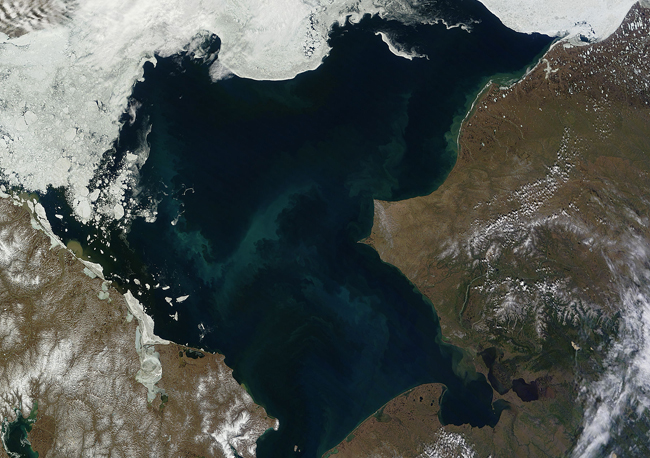Images
July 1, 2015 - Phytoplankton bloom in the Chukchi Sea
Tweet
The waters between Russia and Alaska were tinted with beautiful swirls of greens and blues in mid-June 2015. The Moderate Resolution Imaging Spectroradiometer (MODIS) aboard NASA’s Terra satellite captured this true-color image on June 17.
Russia lies in the west, and Alaska in the east. In the south, the Bering Strait separates the two countries by a mere 53 miles (85 km) at its narrowest point. To the north, the remains of the receding sea ice floats over the blue waters of the Chukchi Sea.
The colorful swirls are caused by large blooms of phytoplankton. These microscopic plants are the base of the marine food chain. Until recently, phytoplankton were thought to grow in this region only after sea ice had retreated for the summer. However, scientists now think that the thinning Arctic ice is allowing sunlight to reach the waters under the sea ice, and encouraging blooms underneath ice – where they had never before been observed.
The Chukchi Sea is a near-pristine environment, with a shallow seafloor that is home to bottom-dwelling species, such as crustaceans and mollusks, to proliferate. Between the phytoplankton and seafloor creatures, the sea becomes a virtual buffet for many fish, diving birds, walrus, seals and whales. About 2,000 polar bears, or about one-tenth of the world’s polar bears call the Sea their home, and are intimately tied to the sea ice, which they use for denning, resting, breeding and hunting. The shelves under the Chukchi Sea are also considered to be rich reserves of oil – and companies are urgently wanting to exploit these resources.
On June 30, 2015, according to Alaska Public Media, the U.S. Fish and Wildlife Services issued a Letter of Authorization to Shell Oil. The authorization allows the oil company to “take small numbers of Polar bears and Pacific walrus incidental to activities occurring during its ‘Outer Continental Shelf 2015’ exploration drilling program in Chukchi Sea”. This drilling is scheduled to begin in July, 2015.
Image Facts
Satellite:
Terra
Date Acquired: 6/17/2015
Resolutions:
1km (182.7 KB), 500m (663.6 KB), 250m (1.6 MB)
Bands Used: 1,4,3
Image Credit:
Jeff Schmaltz, MODIS Land Rapid Response Team, NASA GSFC
Tweet
The waters between Russia and Alaska were tinted with beautiful swirls of greens and blues in mid-June 2015. The Moderate Resolution Imaging Spectroradiometer (MODIS) aboard NASA’s Terra satellite captured this true-color image on June 17.
Russia lies in the west, and Alaska in the east. In the south, the Bering Strait separates the two countries by a mere 53 miles (85 km) at its narrowest point. To the north, the remains of the receding sea ice floats over the blue waters of the Chukchi Sea.
The colorful swirls are caused by large blooms of phytoplankton. These microscopic plants are the base of the marine food chain. Until recently, phytoplankton were thought to grow in this region only after sea ice had retreated for the summer. However, scientists now think that the thinning Arctic ice is allowing sunlight to reach the waters under the sea ice, and encouraging blooms underneath ice – where they had never before been observed.
The Chukchi Sea is a near-pristine environment, with a shallow seafloor that is home to bottom-dwelling species, such as crustaceans and mollusks, to proliferate. Between the phytoplankton and seafloor creatures, the sea becomes a virtual buffet for many fish, diving birds, walrus, seals and whales. About 2,000 polar bears, or about one-tenth of the world’s polar bears call the Sea their home, and are intimately tied to the sea ice, which they use for denning, resting, breeding and hunting. The shelves under the Chukchi Sea are also considered to be rich reserves of oil – and companies are urgently wanting to exploit these resources.
On June 30, 2015, according to Alaska Public Media, the U.S. Fish and Wildlife Services issued a Letter of Authorization to Shell Oil. The authorization allows the oil company to “take small numbers of Polar bears and Pacific walrus incidental to activities occurring during its ‘Outer Continental Shelf 2015’ exploration drilling program in Chukchi Sea”. This drilling is scheduled to begin in July, 2015.
Image Facts
Satellite:
Terra
Date Acquired: 6/17/2015
Resolutions:
1km (182.7 KB), 500m (663.6 KB), 250m (1.6 MB)
Bands Used: 1,4,3
Image Credit:
Jeff Schmaltz, MODIS Land Rapid Response Team, NASA GSFC




